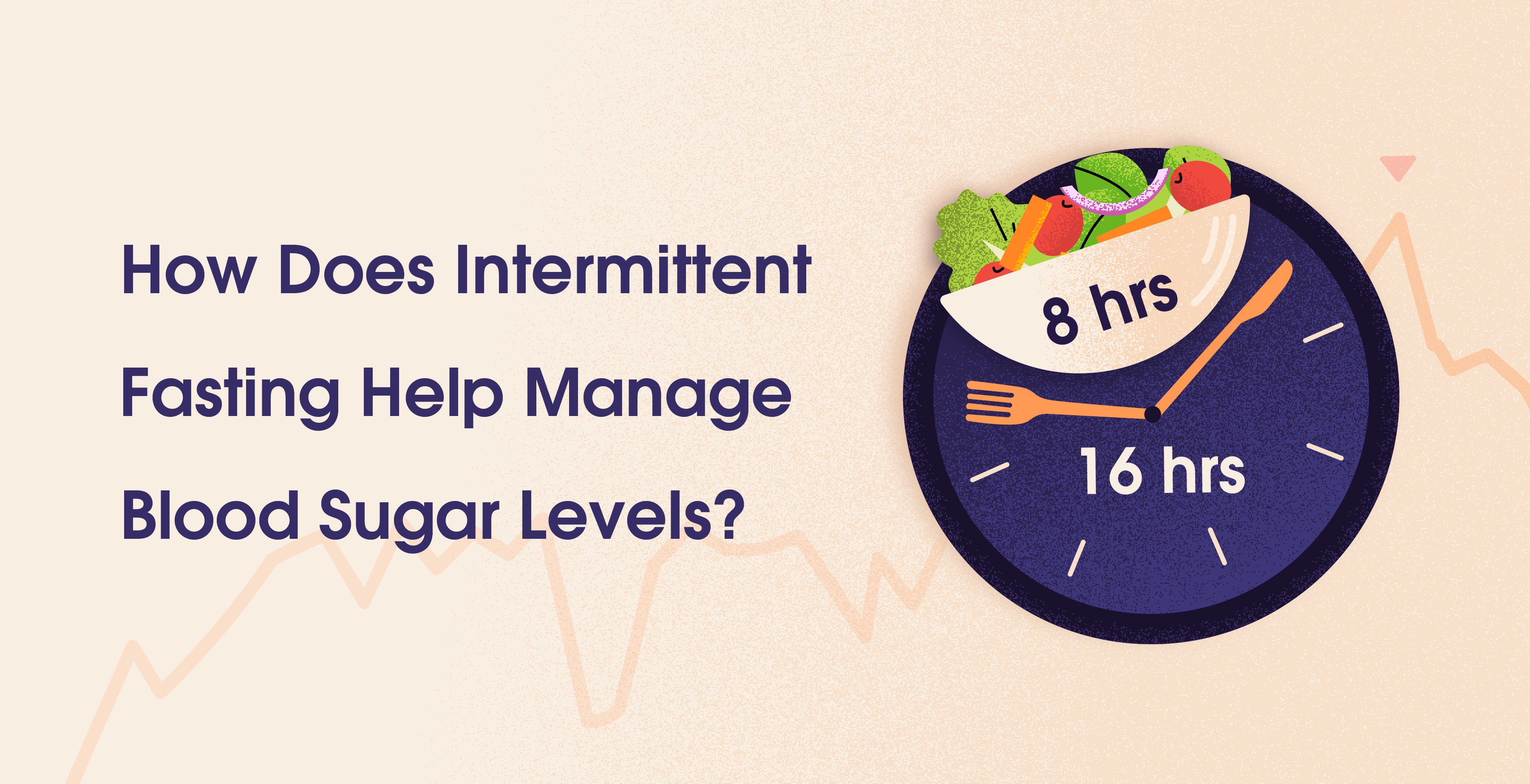Exercise and Prediabetes
Mar 11, 2024
Heer Chedda



Table Of Contents
If you've been diagnosed with prediabetes, I know you're probably not thrilled to hear that one of the main things you can do to manage it is...exercise. I get it, exercising is hard work and can feel like a chore. But if you can get yourself moving a few times a week, it can make a huge impact on getting your blood sugar under control.
And here's some extra motivation for you - exercising is way more effective at reversing prediabetes than just dieting alone. Adding physical activity should absolutely be part of your game plan against this sneaky condition.
Science Between Exercise & Prediabetes
First, what exactly is happening in your body when you have prediabetes? Well, it means your cells have started becoming insensitive to insulin, the hormone that allows your cells to absorb and use glucose from your bloodstream.
To try and compensate for the cells not responding to insulin properly, your poor pancreas starts overproducing insulin like crazy. All this excess insulin results in elevated blood glucose levels, and bam - you've got prediabetes.
Research has shown that getting active with exercise can help reverse these insulin issues and get your blood sugar back in the healthy range. Here are some of the key findings:
Doing aerobic exercise like brisk walking, cycling, or swimming 3-5 times a week for about 30 minutes each session has been shown to lower insulin resistance by an average of 25%.
Combining aerobic workouts with some strength training 2-3 times per week lowers insulin resistance even further - by up to 41% on average!
Most experts recommend getting at least 150 minutes of moderate exercise per week to keep your blood sugar in check. Get your heart pumping for 30 minutes at least 5 days a week.
Losing some extra body fat through exercise can also have incredible benefits - shedding just 5-10% of your body weight can decrease insulin resistance by over 50%!
The evidence is super clear that making exercise a regular habit is one of the best things you can do to get your prediabetes under control and prevent it from progressing to type 2 diabetes.
Benefits of Exercising
Okay, beyond just the science stuff, what are some real-life benefits you can look forward to by working physical activity into your weekly routine if you have prediabetes?
1. Sensitivity to insulin
One of the hallmarks of prediabetes is insulin resistance, meaning your body's cells have become less responsive to the effects of insulin. Exercise can help reverse this by enhancing your cells' sensitivity to insulin. Activities like brisk walking, jogging, cycling, and strength training make your muscles more receptive to insulin.
This allows them to more efficiently take up glucose from your bloodstream and lowers high blood sugar levels. Even a single workout can boost insulin sensitivity for up to 48 hours.
2. Weight loss
Carrying excess weight, especially in the abdominal area, promotes insulin resistance. Exercise is a powerful tool for losing weight and shedding dangerous visceral belly fat. It helps create a calorie deficit to burn fat while also building metabolically active lean muscle mass.
Maintaining a healthy body weight takes pressure off your insulin producing cells and reduces risks associated with prediabetes. Even a 5-10% weight loss can significantly improve blood sugar control.
3. Stress reduction
The good news is that making exercise a regular habit provides a major mental health boost in addition to the physical benefits. When you workout, your body releases endorphins - chemicals that trigger positive feelings and a sense of euphoria.
Even just 30 minutes of moderate cardio like brisk walking is enough to flood your system with endorphins that make you feel more calm, relaxed, and optimistic. The reduction in stress hormones and increase in feel-good endorphins can improve your mood for up to 12 hours after a single workout session!
4. Blood sugar regulation
In addition to increasing insulin sensitivity, exercise directly impacts blood glucose levels. Contracting muscles during physical activity draws glucose out of the bloodstream independently of insulin.
Regular workouts, both aerobic and strength training, have been shown to lower A1C levels (a key marker of blood sugar management) by close to 1% in prediabetics. Keeping blood sugar balanced is critical for reversing insulin resistance.
5. Heart health
Having prediabetes doesn't just affect your blood sugar - it also puts you at higher risk for cardiovascular disease. Exercise strengthens your heart muscle, lowers blood pressure, improves cholesterol levels, and reduces inflammation. This comprehensive protection reduces the chances of experiencing heart attack, stroke, and other complications if you have prediabetes.
6. Reduce the risk of type 2 diabetes
Out of all the benefits exercise provides when you have prediabetes, substantially lowering your risk of developing type 2 diabetes down the road is arguably the most meaningful.
Multiple major scientific studies have shown that committing to regular physical activity - at least 150 minutes of moderate exercise per week - can slash your chances of progressing from prediabetes to a full-blown type 2 diabetes diagnosis by over 50%. Other research finds the risk reduction may be as high as 70%!
By keeping your blood glucose balanced now, you avoid further deterioration of your insulin producing beta cells. This preserves your body's ability to produce adequate insulin for managing energy levels long-term.
Prediabetes Diet and Exercise Plan
Diet Plan
Eat 3 meals and 2 snacks spaced evenly throughout the day - this helps maintain steady blood sugar levels. Don't go more than 4-5 hours without eating.
Eat a hearty breakfast within 1 hour of waking up - this kick starts your metabolism and prevents later blood sugar spikes. Include fiber, protein, and healthy fats.
Have a snack mid-morning - choose something like yogurt, fruit, nuts to tide you over until lunch.
Eat your lunch -frontload your calories early when your body can best use them for energy.
Afternoon snack around 3pm helps prevent crashes - good options are veggies and hummus, cottage cheese, and hard boiled egg.
Eat dinner early, at least 3 hours before bed - gives your body time to digest before sleep. Include lean protein, vegetables.
Note: Limit carbs in evening to avoid nighttime blood sugar spikes. Drink water before meals - helps avoid overeating and balances blood sugar. Avoid caffeine after 2pm
Exercise Plan
Do cardio exercise like walking, cycling, swimming 5 days per week for 30 mins. Moderate-intensity is ideal.
Strength train 2 times per week - use bodyweight, bands, weights to work all major muscle groups. Builds metabolically active muscle.
Take a rest day between strength training days to allow muscles to recover and grow.
On non-intense workout days, do active recovery like gentle yoga, leisurely walking, and mobility exercises.
Increase overall NEAT (non-exercise activity thermogenesis) - take stairs, park farther away, pace during phone calls, etc.
Unconventional Exercises for Prediabetes
Here are some out-of-the-box tips for getting active to manage prediabetes beyond just traditional workouts:
Turn on some lively music and dance around your kitchen or living room. Let loose and get silly if it helps you move more!
Try Soleus Pushups if you live a sedentary lifestyle or are someone who's stuck at their desk from 9-5.
Make a weekly family walk part of your weekend routine. Head to a park, hiking trail, or just loop around the neighborhood together.
Sign up for virtual dance classes in styles like hip-hop, Bollywood, Latin, Zumba. Learning new choreography is fun cardio.
Jump on a trampoline - it provides a great workout with low impact on your joints. A few minutes daily can get your heart pumping.
Buy some used sports equipment like a tennis racket or rollerblades. Local courts and paved trails await your new hobby!
Install a pull-up bar and keep resistance bands handy for intermittent strength training whenever you think of it.
Check Groupon or ClassPass for discounted martial arts classes like kickboxing and MMA. Unleash your inner action hero!
Make an epic playlist for power-cleaning your house. Scrubbing to the beat counts as cardio!
Walk, jog, or bike to run local errands when possible rather than always driving.
Take up gardening - digging, planting, hauling bags of soil definitely gets you moving.
Join a recreational sports team through work, church or community groups. Volleyball, softball, and basketball are fun.
The key is finding activities you actually enjoy, so exercise never feels like a chore. Get creative with ways to be active that fit your lifestyle and personality!
Personal Note :)
When you're dealing with a prediabetes diagnosis, exercise is probably the last thing you feel like doing. You're tired, overwhelmed, and just trying to come to terms with this new health challenge. The thought of adding another "should" to your life feels impossible some days.
But I want to gently encourage you to reconsider being more active, from one human to another. I know it's not easy, but I also know you can do hard things. And the benefits exercise provides are so worth the initial effort.
This isn't about suddenly training for a marathon or giving up your favorite foods. This is about starting small and finding tiny ways to get your body moving that fit into your life. Maybe it's pacing while you chat on the phone or doing a few squats during TV commercials. On days when even that feels hard, be extra kind to yourself.
You have so much strength in you, even if some days are a struggle. And I'll be cheering you on in spirit as you take the first steps. You've got champions in your corner, I promise. I want to help lift you up, not add more burden.
I believe in you. And there is so much hope ahead. Prediabetes does not have to define your future if you take action now. Keep hanging in there, and remember that progress happens slowly. But when you look back months from now, you'll see how far you've come. This is not easy, but you are not alone.
Frequently Asked Questions
Can I reverse prediabetes with diet and exercise?
Adopting a healthy diet rich in whole grains, fruits, vegetables, and lean proteins combined with regular exercise can definitely help reverse prediabetes. Focus on maintaining a balanced lifestyle, managing stress, and staying consistent with your habits. Small changes can make a big difference in improving your blood sugar levels and overall health.
How to control prediabetes with diet and exercise?
Controlling prediabetes with diet and exercise involves making sustainable lifestyle changes. Aim for a balanced diet rich in fiber, whole grains, lean proteins, and healthy fats. Incorporate regular physical activity like brisk walking, swimming, or cycling for at least 30 minutes most days of the week. Monitor your blood sugar levels regularly and work with a healthcare professional to adjust your plan as needed.
Can exercise help prediabetes?
The short answer is Yes, absolutely! The long answer? Read the blog!
How much exercise does it take to reverse prediabetes?
The amount of exercise needed to reverse prediabetes can vary from person to person, but generally, aim for at least 150 minutes of moderate-intensity aerobic activity per week, spread throughout the week. This could include brisk walking, cycling, swimming, or any activity that gets your heart rate up. Additionally, incorporating strength training exercises two or more days a week can also be beneficial.
When is the best time for a pre diabetic to exercise?
The best time for a prediabetic to exercise is whenever it fits into their schedule and feels most comfortable. Some people prefer exercising in the morning to jumpstart their metabolism and energize their day, while others find it more convenient to exercise during their lunch break or in the evening after work. The most important thing is to find a time that allows for consistency and adherence to your exercise routine. Additionally, consider factors like blood sugar levels, meal timing, and personal preferences when deciding on the best time to exercise.
References
If you've been diagnosed with prediabetes, I know you're probably not thrilled to hear that one of the main things you can do to manage it is...exercise. I get it, exercising is hard work and can feel like a chore. But if you can get yourself moving a few times a week, it can make a huge impact on getting your blood sugar under control.
And here's some extra motivation for you - exercising is way more effective at reversing prediabetes than just dieting alone. Adding physical activity should absolutely be part of your game plan against this sneaky condition.
Science Between Exercise & Prediabetes
First, what exactly is happening in your body when you have prediabetes? Well, it means your cells have started becoming insensitive to insulin, the hormone that allows your cells to absorb and use glucose from your bloodstream.
To try and compensate for the cells not responding to insulin properly, your poor pancreas starts overproducing insulin like crazy. All this excess insulin results in elevated blood glucose levels, and bam - you've got prediabetes.
Research has shown that getting active with exercise can help reverse these insulin issues and get your blood sugar back in the healthy range. Here are some of the key findings:
Doing aerobic exercise like brisk walking, cycling, or swimming 3-5 times a week for about 30 minutes each session has been shown to lower insulin resistance by an average of 25%.
Combining aerobic workouts with some strength training 2-3 times per week lowers insulin resistance even further - by up to 41% on average!
Most experts recommend getting at least 150 minutes of moderate exercise per week to keep your blood sugar in check. Get your heart pumping for 30 minutes at least 5 days a week.
Losing some extra body fat through exercise can also have incredible benefits - shedding just 5-10% of your body weight can decrease insulin resistance by over 50%!
The evidence is super clear that making exercise a regular habit is one of the best things you can do to get your prediabetes under control and prevent it from progressing to type 2 diabetes.
Benefits of Exercising
Okay, beyond just the science stuff, what are some real-life benefits you can look forward to by working physical activity into your weekly routine if you have prediabetes?
1. Sensitivity to insulin
One of the hallmarks of prediabetes is insulin resistance, meaning your body's cells have become less responsive to the effects of insulin. Exercise can help reverse this by enhancing your cells' sensitivity to insulin. Activities like brisk walking, jogging, cycling, and strength training make your muscles more receptive to insulin.
This allows them to more efficiently take up glucose from your bloodstream and lowers high blood sugar levels. Even a single workout can boost insulin sensitivity for up to 48 hours.
2. Weight loss
Carrying excess weight, especially in the abdominal area, promotes insulin resistance. Exercise is a powerful tool for losing weight and shedding dangerous visceral belly fat. It helps create a calorie deficit to burn fat while also building metabolically active lean muscle mass.
Maintaining a healthy body weight takes pressure off your insulin producing cells and reduces risks associated with prediabetes. Even a 5-10% weight loss can significantly improve blood sugar control.
3. Stress reduction
The good news is that making exercise a regular habit provides a major mental health boost in addition to the physical benefits. When you workout, your body releases endorphins - chemicals that trigger positive feelings and a sense of euphoria.
Even just 30 minutes of moderate cardio like brisk walking is enough to flood your system with endorphins that make you feel more calm, relaxed, and optimistic. The reduction in stress hormones and increase in feel-good endorphins can improve your mood for up to 12 hours after a single workout session!
4. Blood sugar regulation
In addition to increasing insulin sensitivity, exercise directly impacts blood glucose levels. Contracting muscles during physical activity draws glucose out of the bloodstream independently of insulin.
Regular workouts, both aerobic and strength training, have been shown to lower A1C levels (a key marker of blood sugar management) by close to 1% in prediabetics. Keeping blood sugar balanced is critical for reversing insulin resistance.
5. Heart health
Having prediabetes doesn't just affect your blood sugar - it also puts you at higher risk for cardiovascular disease. Exercise strengthens your heart muscle, lowers blood pressure, improves cholesterol levels, and reduces inflammation. This comprehensive protection reduces the chances of experiencing heart attack, stroke, and other complications if you have prediabetes.
6. Reduce the risk of type 2 diabetes
Out of all the benefits exercise provides when you have prediabetes, substantially lowering your risk of developing type 2 diabetes down the road is arguably the most meaningful.
Multiple major scientific studies have shown that committing to regular physical activity - at least 150 minutes of moderate exercise per week - can slash your chances of progressing from prediabetes to a full-blown type 2 diabetes diagnosis by over 50%. Other research finds the risk reduction may be as high as 70%!
By keeping your blood glucose balanced now, you avoid further deterioration of your insulin producing beta cells. This preserves your body's ability to produce adequate insulin for managing energy levels long-term.
Prediabetes Diet and Exercise Plan
Diet Plan
Eat 3 meals and 2 snacks spaced evenly throughout the day - this helps maintain steady blood sugar levels. Don't go more than 4-5 hours without eating.
Eat a hearty breakfast within 1 hour of waking up - this kick starts your metabolism and prevents later blood sugar spikes. Include fiber, protein, and healthy fats.
Have a snack mid-morning - choose something like yogurt, fruit, nuts to tide you over until lunch.
Eat your lunch -frontload your calories early when your body can best use them for energy.
Afternoon snack around 3pm helps prevent crashes - good options are veggies and hummus, cottage cheese, and hard boiled egg.
Eat dinner early, at least 3 hours before bed - gives your body time to digest before sleep. Include lean protein, vegetables.
Note: Limit carbs in evening to avoid nighttime blood sugar spikes. Drink water before meals - helps avoid overeating and balances blood sugar. Avoid caffeine after 2pm
Exercise Plan
Do cardio exercise like walking, cycling, swimming 5 days per week for 30 mins. Moderate-intensity is ideal.
Strength train 2 times per week - use bodyweight, bands, weights to work all major muscle groups. Builds metabolically active muscle.
Take a rest day between strength training days to allow muscles to recover and grow.
On non-intense workout days, do active recovery like gentle yoga, leisurely walking, and mobility exercises.
Increase overall NEAT (non-exercise activity thermogenesis) - take stairs, park farther away, pace during phone calls, etc.
Unconventional Exercises for Prediabetes
Here are some out-of-the-box tips for getting active to manage prediabetes beyond just traditional workouts:
Turn on some lively music and dance around your kitchen or living room. Let loose and get silly if it helps you move more!
Try Soleus Pushups if you live a sedentary lifestyle or are someone who's stuck at their desk from 9-5.
Make a weekly family walk part of your weekend routine. Head to a park, hiking trail, or just loop around the neighborhood together.
Sign up for virtual dance classes in styles like hip-hop, Bollywood, Latin, Zumba. Learning new choreography is fun cardio.
Jump on a trampoline - it provides a great workout with low impact on your joints. A few minutes daily can get your heart pumping.
Buy some used sports equipment like a tennis racket or rollerblades. Local courts and paved trails await your new hobby!
Install a pull-up bar and keep resistance bands handy for intermittent strength training whenever you think of it.
Check Groupon or ClassPass for discounted martial arts classes like kickboxing and MMA. Unleash your inner action hero!
Make an epic playlist for power-cleaning your house. Scrubbing to the beat counts as cardio!
Walk, jog, or bike to run local errands when possible rather than always driving.
Take up gardening - digging, planting, hauling bags of soil definitely gets you moving.
Join a recreational sports team through work, church or community groups. Volleyball, softball, and basketball are fun.
The key is finding activities you actually enjoy, so exercise never feels like a chore. Get creative with ways to be active that fit your lifestyle and personality!
Personal Note :)
When you're dealing with a prediabetes diagnosis, exercise is probably the last thing you feel like doing. You're tired, overwhelmed, and just trying to come to terms with this new health challenge. The thought of adding another "should" to your life feels impossible some days.
But I want to gently encourage you to reconsider being more active, from one human to another. I know it's not easy, but I also know you can do hard things. And the benefits exercise provides are so worth the initial effort.
This isn't about suddenly training for a marathon or giving up your favorite foods. This is about starting small and finding tiny ways to get your body moving that fit into your life. Maybe it's pacing while you chat on the phone or doing a few squats during TV commercials. On days when even that feels hard, be extra kind to yourself.
You have so much strength in you, even if some days are a struggle. And I'll be cheering you on in spirit as you take the first steps. You've got champions in your corner, I promise. I want to help lift you up, not add more burden.
I believe in you. And there is so much hope ahead. Prediabetes does not have to define your future if you take action now. Keep hanging in there, and remember that progress happens slowly. But when you look back months from now, you'll see how far you've come. This is not easy, but you are not alone.
Frequently Asked Questions
Can I reverse prediabetes with diet and exercise?
Adopting a healthy diet rich in whole grains, fruits, vegetables, and lean proteins combined with regular exercise can definitely help reverse prediabetes. Focus on maintaining a balanced lifestyle, managing stress, and staying consistent with your habits. Small changes can make a big difference in improving your blood sugar levels and overall health.
How to control prediabetes with diet and exercise?
Controlling prediabetes with diet and exercise involves making sustainable lifestyle changes. Aim for a balanced diet rich in fiber, whole grains, lean proteins, and healthy fats. Incorporate regular physical activity like brisk walking, swimming, or cycling for at least 30 minutes most days of the week. Monitor your blood sugar levels regularly and work with a healthcare professional to adjust your plan as needed.
Can exercise help prediabetes?
The short answer is Yes, absolutely! The long answer? Read the blog!
How much exercise does it take to reverse prediabetes?
The amount of exercise needed to reverse prediabetes can vary from person to person, but generally, aim for at least 150 minutes of moderate-intensity aerobic activity per week, spread throughout the week. This could include brisk walking, cycling, swimming, or any activity that gets your heart rate up. Additionally, incorporating strength training exercises two or more days a week can also be beneficial.
When is the best time for a pre diabetic to exercise?
The best time for a prediabetic to exercise is whenever it fits into their schedule and feels most comfortable. Some people prefer exercising in the morning to jumpstart their metabolism and energize their day, while others find it more convenient to exercise during their lunch break or in the evening after work. The most important thing is to find a time that allows for consistency and adherence to your exercise routine. Additionally, consider factors like blood sugar levels, meal timing, and personal preferences when deciding on the best time to exercise.
References
Table Of Contents
Table Of Contents
Table Of Contents
Read More


Mar 25, 2025
Sayfali Rawlani


Mar 20, 2025
Sayfali Rawlani


Mar 6, 2025
Sayfali Rawlani



Company
Copyright © 2025 trst health. All right reserved.

